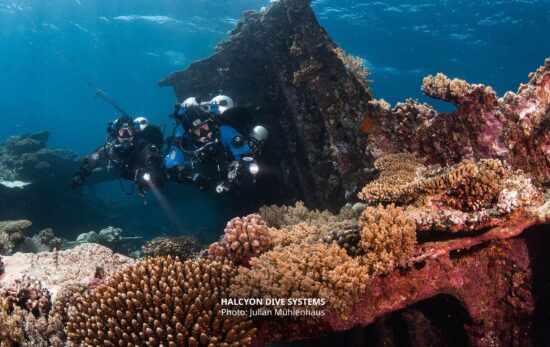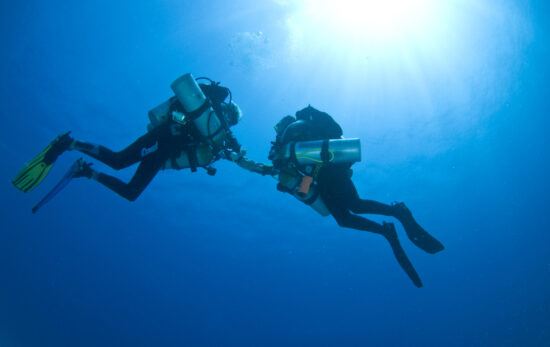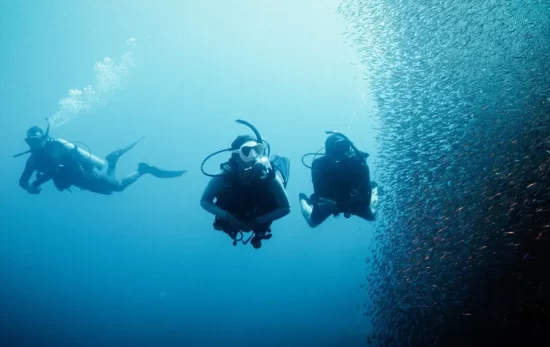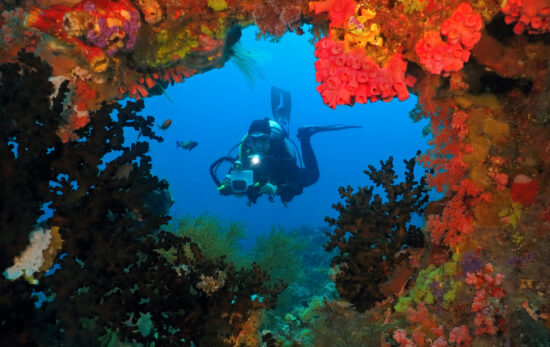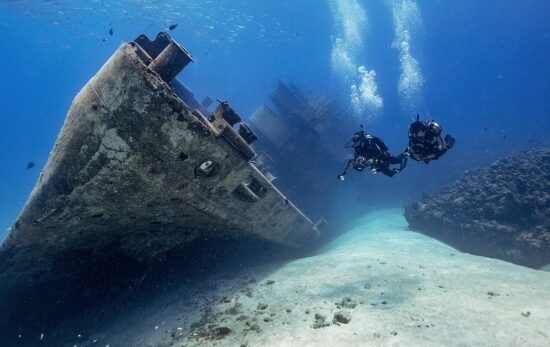Namibia has some amazing diving places for technical diving. We have Dragon’s Breath, the largest underwater lake in the world, Otjikoto lake, with some German First World War cannons, and the extensive cave systems of Guinas and Harisep lakes. The latter are commonly visited by expeditions from all around the world who leave fascinated by the sites’ beauty and uniqueness.
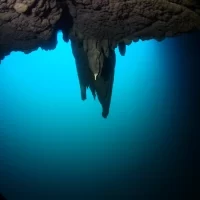
However, those lakes lie 450 km (380 miles) from Windhoek, the capital of Namibia and the place where most of the dive community lives. For recreational diver training, we usually use Oanob and Friedenau dams, two lakes that lie around 90 km (56 miles) from the town with very limited visibility. In addition to the low visibility environment, they have other hazards. If the bottom is touched below 12m (39 feet), the thin dust produces a zero visibility environment (the reason why we never go deeper with more than one student). We also have lots of fishing lines, the thermocline is quite strong (from 20 to 12 degrees Celsius / 68 to 54 degrees Fahrenheit in summer), and in Friedenau Dam, we have huge sharp-tooth catfish that normally swim in packs around you, quite a scary feeling when torches are the only source of light.
However, after more than a hundred PADI certifications at Oanob and Friedenau dam and with the support of the Windhoek Underwarter Club, where I teach and stand as the Training Officer, I decided to start technical training at Oanob. First I started diving with slings and a rebreather, and once the techniques were developed, the teaching started.
The Advantages of Mud
Before teaching in Namibia, I did all my professional training in Jamaica, a beautiful paradise with clear warm waters. I have participated in a good number of training dives in clear water environments, and I have to say, there is no better place to teach people than mud. The reason? The limited visibility has three effects on students. First, they only focus on the training (there is nothing to see, except rocks, submerged trees and, once in a while, the shade of a fish). Second, they have to be very close to the bottom, and the bottom is muddy with a very disgusting, slimy feeling (we even have lots of leeches in the mud, and, by the way, gloves are not allowed in training dives). Finally, we can only teach in a one-on-one or one-on-two ratio as a maximum. We have found that our students have an excellent record when they dive at any “normal” diving spot. In fact, we even developed a Distinctive specialty for PADI, Limited Visibility Diver (available on request).
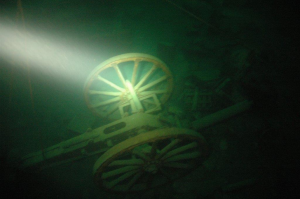
At one point, I decided it was time to start practicing my tech skills in the dam. I brought my rebreather, my slings and I started to practice my drills. My unit requires me to have at least two gases for any dive deeper than 20m (66 feet). The first gas, a Eanx 50, allows you to breath from the surface in the loop, due to the oxygen drop of all pSCRs. The second one is for any dive deeper than 20m (66 feet) where the pp O2 becomes too high if diving with a mix of Eanx 50. The first dives were not too good. The slings and the reels were a problem because they tend to be lower than the body (silting the entire area). Deploying a DSMB from the bottom was hectic, since as soon as the bottom was touched, the silt makes the area absolutely dark. I couldn’t even see anything with canister torches.
But, little by little, things became easier. I did the first dives in the photic zone, where the silting is not so bad, and as I became more comfortable, I started trying to go deeper and deeper. This process really helped me to improve a lot as a diver:
- First, I started practicing deploying the DSMB without kicking. Instead, I’d remain horizontal with perfect buoyancy. This skill proved very useful.
- In the sea or in a lake, you may deploy your DSMB while kicking in order to maintain position. However, since kicking was not an option due to the silting and there is zero reference for depth in the pitch black, I was forced to practice deploying a DSMB horizontally, very close to the bottom, without silting it.
- Second, I practiced deploying a DSMB from the bottom. As soon as the bottom is touched, there is a zero visibility. So, I started practicing to deploy a DSMB with no visual reference. It improved the speed I can deploy a DSMB and mechanically trained my mind in doing so.
- Third, I did S-drills. Again, I practiced with perfect buoyancy. From 40 cm (16 inches) above the bottom, there is no visual reference for depth. So, I started practicing the S-Drill until I was able to do it without losing reference of the bottom. This skill also proved very useful for improving my buoyancy when doing the skill in normal waters.
- Fourth, I started working with staging cylinders. Staging cylinders in murky waters is a different game. Dropping the cylinder has to be very smooth, and recovering does not give you any chance to make mistakes. If the bottom is touched, the visibility will become zero, and you will lose position. From this point, I had perfected how I staged cylinders, from taking it out without touching the bottom or losing my depth to maintaining the perfect buoyancy while releasing a cylinder and retrieving them without losing reference of the bottom or silting it.
- Fifth and most important, I practiced knowing where my body and equipment was. In training we insist on streamlining our equipment, but in this case, even the smallest mistake or wrong positioning of reels or any other equipment will silt the area. If a cylinder hangs 20 cm (8 inches) below you and you can only see 40cm (16 inches), it gives you only 20 cm (8 inches) of free space between you and the bottom. The use of butt plates slightly improves the positioning of the cylinders.
With this positive experience, we decided to start our tech training and practice in these low visibility environments in Namibia. Even though the dam can go quite deep, we decided that we will only do training for Tec 40, 45 and 50 there. We prefer to reserve the last dive for the beautiful lakes of the north.
Finally, after all those dives and training, I developed a series of techniques specifically for tec dives in very low visibility. I found that carrying an SMB attached to a strong rope and having the deco gases staged at the maximum useful depth simplified the diving a lot. I had to accept the additional drag, but I was more relaxed on my dives. An alternative is to attach the deco gases to the descent/ascent line and dive from it with a reel (double clipped). Having Jon lines (a line between two buddies) is a problem, as you have to dive so close to the bottom it is very likely that the line will get stuck on the bottom, increases your chances of entanglement and of silting the area.
Another thing that I found useful is that no tech dive should ever be done in those waters without surface support. I established a color/marking code with the surface so they will can identify the problem and help. The reason being that if the bottom is touched, the viz will become zero, and it will be difficult for any teammate (unless using reels to keep contact) to help. Also, the deco schedule and the time needed just to find the teammate (we recommend to ascend to a predetermined depth and start an expanding square search) will make it very difficult to retrieve the teammate in time. For that reason, being able to deploy a DSMB from the bottom at zero viz and having a support team able to come down and help is absolutely a must in our training. These are just examples of training programs we have developed to dive in this situation.
Training in Mud, Diving in Water
To sum up, use your local quarry for your technical training. It will give you the opportunity to improve your skills much more than in any other place. It’s also likely to be close to home, and the conditions are the best for any training, from Open Water Diver to technical diving. Practice and re-practice your drills there, enjoy being underwater (even if you cannot see much) and you will see how you become a much better and more confident diver.
This article was originally written in 2015 for the TecRec blog by David Martin Castro, a PADI Tec Deep Instructor and member of the Windhoek Underwater Club.
